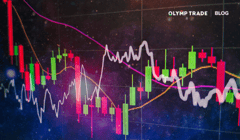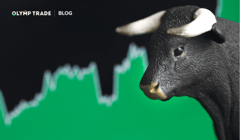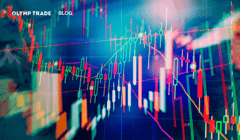This Expert Review covers the week from 28.02.2022 to 06.03.2022.

The Russia-Ukraine crisis escalated last week, affecting commodities and defensive assets. EUR/USD began to decline. What does this mean and how will it affect the markets? Read in today's digest.
Contents
Interact with the underlined words and green dots to get additional details and explanations.
Additional context for the visuals.
Explanations and definitions of terms.
Weekly Trends
EUR/USD ↓ 1.2%
Trading up with $100 and a X500 multiplier on Forex Olymp Trade, you could have easily made $600.
GBP/USD ↓ 1.52%
Trading up with $100 and a X500 multiplier on Forex Olymp Trade, you could have easily made $760.
Meta ↓ 8.62%
Trading down with $100 and a X20 multiplier on Forex Olymp Trade, you could have easily made $172.40.
Currency Markets
Geopolitical tensions strengthen the US Dollar
Over the past week, USD strengthened its positions.
The upward movement of the U.S. currency was largely due to the withdrawal of investors from risks amid the escalation of conflict between Russia and Ukraine. The growth was also supported by strong macroeconomic statistics.
On Tuesday 22.02, the US Consumer Confidence index was published. The data came in better than expected at 110.5, against a forecast of 110. U.S. GDP data released on Thursday was in line with expectations at +7%. This is positive news for the U.S. economy.

Note that the FOMC has not even started to raise its key rate yet. We believe with a high probability that USD will continue to grow. The first downside target for EUR/USD is 1.0880, and the next target is at 1.05000.

Second target for EUR/USD. 1.05000
First target for EUR/USD
Inflation Increase
Inflation continues to be a major risk for developed markets.
Many European countries are currently experiencing inflation rates that continue to break historical records.

In this light, it is not surprising that the tone of the monetary policy authorities is becoming more and more hawkish. On Wednesday 23.02 the Reserve Bank of New Zealand decided to raise the key rate by 25 b.p. to 1%. The head of the Central Bank stated that the rate should be raised significantly, but an immediate increase of 0.5% is ruled out. In addition, the Central Bank needs to roll back stimulus measures.
Under these circumstances, the New Zealand dollar rose against other currencies, but a correction followed the next day. The NZD/USD currency pair fell back below 0.67400. On the weekly chart, we see a typical bearish flag technical pattern, which means the downward movement may continue. If the price breaks and secures below 0.66800, the next downside target may become 0.65900.

RSI indicator - a momentum indicator used in technical analysis that measures the magnitude of recent price changes to evaluate overbought or oversold conditions
Price target
Stock Markets
A Full Fledged Decline in U.S. Indices
The U.S. stock market has officially entered a phase of decline.
One of the triggers was, of course, geopolitics. The Dow Jones dropped by 3.4%, the Nasdaq100 lost about 5%, and the S&P 500 fell by 3.5%.

On the daily chart, the Dow Jones index left the bearish range and broke the level of 34000 points down. At present, the possibility of further declines remains open for bears.
Tesla's Collapse
One of the hardest-hit stocks was Tesla.
The company's shares fell by more than 18%. The drop in the company's stock was caused by another lawsuit from a former employee accusing the company of racism. This is not the first case. Since 2016, at least 90 racially motivated lawsuits have been filed against the company. The last high-profile decision on such a claim was made last October when the company was ordered to pay out $137M. Naturally, such stories don’t have a positive impact on the capitalization of the electric car manufacturer. However, it's not the most important thing.
In terms of key market multipliers, the company is significantly ahead of the industry, which suggests that the company's shares are extremely overbought. Tesla's P/E Ratio is 155, while the median in the industry is 104. It's likely that the decline will continue. The price has broken the 200 moving average down. The target for Tesla stock is $550.

Trend-line. Resistance level
Price target
200-EMA
Commodity Markets
Shocking growth in the commodities market
Oil and gold are reaching new highs.
Brent added more than 7% in a day and broke through the level of $100 per barrel. The "war premium" raised the price of oil to levels last seen in August 2014. The nearest resistance level is at $106.5, which corresponds to the 2nd Fibo level of the current uptrend. Daily RSI is already in the overbought area and after such impulse growth we can expect a correction. However, the market is at the mercy of news, primarily because of the military conflict between Russia and Ukraine. Further aggression in the region and sanctions against Russia will push prices even higher.

RSI inside oversold zone
Prices are rising primarily due to expectations of tough sanctions against Russia in the energy sector. Germany confirmed a freeze on procedures related to Nord Stream-2 and suspended certification of the pipeline. The United States has imposed sanctions on the project and its operator Nord Stream 2 AG, as well as on Russia's sovereign debt. New sanctions may also impose restrictions on the supply and use of fuel production and processing technologies.
The Iraqi Ministry of Oil pointed out the importance of Russian oil for the world market and its consumers. Although the situation in the region has locally taken second place, talks between the U.S. and Iran on the nuclear program are still ongoing. If sanctions are lifted from the country, members of OPEC do not expect Iran to withdraw and will make a decision on its production primarily based on the country's ability to comply with its obligations. The renewal of supplies from Iran is likely to have a negative impact on the price of oil.
Gold is renewing new highs
Investors continue to increase their positions in gold as the main safe haven asset.
The price of the precious metal reached $1974.5 per troy ounce, returning to the levels observed at the end of 2020. The asset has been growing for 4 weeks in a row and it has already become obvious that gold came out of a long consolidation and will continue to grow in the mid to long term.

Local maximums of 2020 and 2021
The conflict between Russia and Ukraine may cause a surge in inflation. Energy prices are making new highs, which directly affects the consumer price index. Investors will likely continue to buy gold as insurance against inflation. Credit Suisse believes the asset could rise to $2,075 in the mid-term.
Cryptocurrency Markets
Bitcoin dropped by more than 8.5% amid the outbreak of military actions in the Donbass.
Last week destroyed any hope for a potential break in the mid-term trend.
Bitcoin, followed the stock market and dropped as the geopolitical situation worsened and hostilities between Russian and Ukrainian forces began. According to a report by Arcane Research, the correlation between Bitcoin and the S&P 500 index reached the highest since October 2020. The major cryptocurrency returned to the $35,000 mark, which is the local low and support level from late January. For the week, the drop was about 19%.
Last week destroyed any hope for a potential break in the mid-term trend. In terms of technical analysis, BTC is in a strong bearish phase. Daily RSI is near the overbought zone, which slightly increases the chance that the current level of $35,000 will not be broken. Nevertheless, the fundamental background and local panic in most markets are likely to play a decisive role for the further price movement.

RSI is near overbought zone
The capitalization of the crypto market decreased by almost $0.5T to $1.58T. The daily trading volume rose to $122 billion due to massive sell-offs.

The Fear and Greed Index spiraled toward Extreme Fear at 23 points. Retail traders are trying to buy the dip, with a slight advantage observed on the buyers' side. The BTC dominance index rose by 1% over the week to 41%. Altcoins are selling more actively than Bitcoin.
Local Crypto News
Ethereum ZK Rollups.
EVM-compatible Layer 2 (L2) solutions using ZK Rollups technology were launched on the Ethereum test network. This is a key element for blockchain scalability according to Vitalik Buterin's vision, while only a year ago very few imagined that it would be implemented in the near future.
Bypassing SWIFT?
The Central Bank of Russia began testing CBDC in several Russian banks, but also continues to support a complete ban on cryptocurrencies in the country. The acceleration to launch the digital ruble can be considered as additional financial protection in case of being disconnected from SWIFT.
$1 Billion for UST.
Luna Foundation Guard raised $1B after a private round of sales of the LUNA token to a number of crypto investors, including Jump Crypto and Three Arrows Capital. The funds raised will be used to maintain the stability of the UST stablecoin in the Terra ecosystem.
Risk warning: The content of the article does not constitute investment advice and you are solely responsible for your trading activity and/or trading results.
Conference Board (CB) Consumer Confidence measures the level of consumer confidence in economic activity. It is a leading indicator as it can predict consumer spending, which plays a major role in overall economic activity.
Gross domestic product (GDP) is the total monetary or market value of all the finished goods and services produced within a country's borders in a specific time period.
An inflation hawk, also known in monetary jargon as a hawk, is a policymaker or advisor who is predominantly concerned with the potential impact of interest rates as they relate to fiscal policy. Hawks are seen as willing to allow interest rates to rise in order to keep inflation under control.
The key rate is the specific interest rate that determines bank lending rates and the cost of credit for borrowers.
Quantitative easing (QE) is a form of unconventional monetary policy in which a central bank purchases longer-term securities from the open market in order to increase the money supply and encourage lending and investment. Buying these securities adds new money to the economy, and also serves to lower interest rates by bidding up fixed-income securities.
The flag pattern is used to identify the possible continuation of a previous trend from a point at which price has drifted against that same trend. Should the trend resume, the price increase could be rapid, making the timing of a trade advantageous by noticing the flag pattern.
The Dow Jones Industrial Average (DJIA), also known as the Dow 30, is a stock market index that tracks 30 large, publicly-owned blue-chip companies trading on the New York Stock Exchange (NYSE) and the Nasdaq.
A bear position is a short position taken on a financial security with the expectation that the price or value of the security will decrease.
The price-to-earnings ratio (P/E ratio) is the ratio for valuing a company that measures its current share price relative to its earnings per share (EPS). The price-to-earnings ratio is also sometimes known as the price multiple or the earnings multiple.
The relative strength index (RSI) is a technical analysis indicator that shows the strength of a trend and evaluates overbought or oversold zones in the price of an asset.
OPEC (Organization of Petroleum Exporting Countries)- a number of oil producing and oil exporting countries united to regulate oil production and control oil prices.
The relative strength index (RSI) is a technical analysis indicator that shows the strength of a trend and evaluates overbought or oversold zones in the price of an asset.
Index measures the sentiment of the cryptocurrency market, analyzing emotions and sentiments from different sources. A value of 0 means "Extreme Fear" while a value of 100 represents "Extreme Greed".











